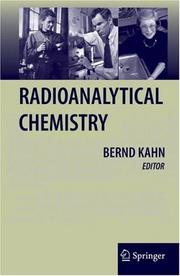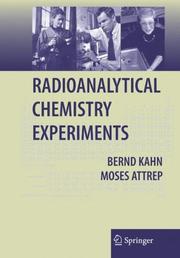| Listing 1 - 2 of 2 |
Sort by
|

ISBN: 9780387341224 9780387341231 0387341226 Year: 2007 Publisher: New York NY Springer New York
Abstract | Keywords | Export | Availability | Bookmark
 Loading...
Loading...Choose an application
- Reference Manager
- EndNote
- RefWorks (Direct export to RefWorks)
BERND KAHN 1.1. Background Radioanalytical chemistry is devoted to analyzing samples for their radio- clide content. For this purpose, the strategies of identifying and purifying the radioelements of interest by chemical methods, and of identifying and meas- ing the disintegration rate (activity ) of radionuclides by nuclear methods, are combined. Radioanalytical chemistry can be considered to be a specialty in the subdiscipline of nuclear and radiochemistry. This textbook was written to teach radioanalytical chemistry in the classroom and support its application in the laboratory. Its emphasis is on the practical - pects of the specialty, notably setting up the laboratory, training its staff, and operating it reliably. The information presented herein, outlined in Section 1.4, is the accumulated product of a century of nuclear chemistry and radiochemistry practice. Radioanalyticalchemistrywas?rstdevelopedbyMme.M.Curie,withcontri- tionsbymanyotherdistinguishedresearchers,notablyE.RutherfordandF.Soddy. These pioneers performed chemical separations and radiation measurements on terrestrial radioactive substances during the 20 years following 1897 and in the process created the very concept of radionuclides. Their investigations de?ned the three major radiation types, con?rmed the emission of these radiations by the nucleus and the associated atomic transformations, established the periodic table between bismuth and uranium, and demonstrated the distinction between stable and radioactive isotopes. Thereafter, cosmic rays were observed and explained, and many cosmic-r- produced radionuclides were identi?ed. The number of known and charact- ized radionuclides increased dramatically with the development and application of nuclear-particle accelerators in the 1930s and nuclear-?ssion reactors in the 1940s.
Radiochemical analysis --- 543.53 --- 543.53 Radiochemical methods of analysis. Activation analysis (analysis with radiations exciting radioactivity or nuclear reactions) --- Radiochemical methods of analysis. Activation analysis (analysis with radiations exciting radioactivity or nuclear reactions) --- Analytical chemistry --- Radiochemistry

ISBN: 9780387469140 9780387469256 Year: 2008 Publisher: New York NY Springer New York
Abstract | Keywords | Export | Availability | Bookmark
 Loading...
Loading...Choose an application
- Reference Manager
- EndNote
- RefWorks (Direct export to RefWorks)
The education of the radioanalytical chemist has two critical components: theory and practice. The textbook Radioanalytical Chemistry was designed to address the theory component of this education. This laboratory manual accompanies and complements that textbook. This manual provides a framework for the student to hone their laboratory skills, with emphasis on safety, research, experimental design, instrumentation and appropriate laboratory methods.
Radiochemical analysis --- 543.53 --- 543.53 Radiochemical methods of analysis. Activation analysis (analysis with radiations exciting radioactivity or nuclear reactions) --- Radiochemical methods of analysis. Activation analysis (analysis with radiations exciting radioactivity or nuclear reactions) --- Analytical chemistry --- Radiochemistry
| Listing 1 - 2 of 2 |
Sort by
|

 Search
Search Feedback
Feedback About UniCat
About UniCat  Help
Help News
News